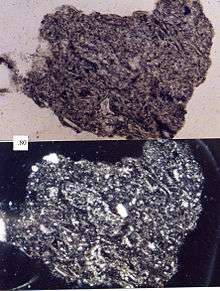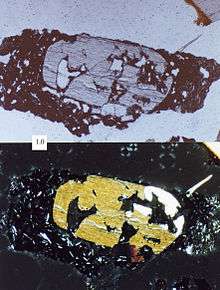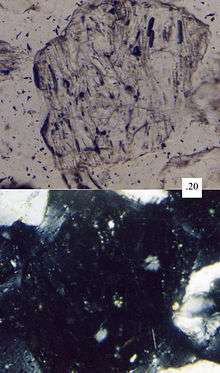Lithic fragment (geology)
Lithic fragments, or lithics, are pieces of other rocks that have been eroded down to sand size and now are sand grains in a sedimentary rock. They were first described and named (in their modern definitions) by Bill Dickinson in 1970.[1] Lithic fragments can be derived from sedimentary, igneous or metamorphic rocks). A lithic fragment is defined using the Gazzi-Dickinson point-counting method and being in the sand-size fraction. Sand grains in sedimentary rocks that are fragments of larger rocks that are not identified using the Gazzi-Dickinson method are usually called rock fragments instead of lithic fragments. Sandstones rich in lithic fragments are called lithic sandstones.
Types of lithic fragments
Igneous (Lv)
These can include granular (~rhyolitic), microlitic (~andesitic), lathwork (~basaltic), and vitric (glassy). These correlations between composition and volcanic lithic fragment type are approximate, at best.[2] By definition, intrusive igneous rock fragments can not be considered lithic fragments.
Sedimentary (Ls)
These can include shale siltstone fragments, and (at times) chert.
Metamorphic (Lm)
These can include fine-grained schist and phyllite fragments, among others.
-

Granular volcanic lithic fragment, scale in millimeters Top picture in plane-polarized light, bottom picture in cross-polarized light.
-

Microlitic volcanic lithic fragment, scale in millimeters. Top picture in plane-polarized light, bottom picture in cross-polarized light.
-

Lathwork volcanic lithic fragment, scale in millimeters. Top picture in plane-polarized light, bottom picture in cross-polarized light.
-

Vitric volcanic lithic fragment, scale in millimeters. Top picture in plane-polarized light, bottom picture in cross-polarized light.
References
- ↑ Dickinson, W.R., 1970, Interpreting detrital modes of graywacke and arkose: Journal of Sedimentary Petrology, v. 40, p. 695–707.
- ↑ Affolter, M.D. and Hendrix, M. S., 2004, Correlations between volcanic lithic fragments and volcanic rock, Geological Society of America Abstracts with Programs, Vol. 36, No. 5, p. 370